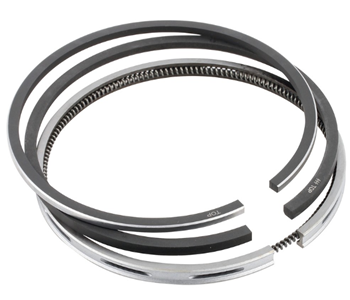The piston ring is the core component of the fuel engine. It seals the fuel gas with the cylinder, piston, and cylinder wall. Piston ring functions include four functions: sealing, adjusting engine oil (oil control), heat conduction (heat transfer), and guide (support).

piston ring's role
1. Sealing: refers to sealing the gas, preventing the gas in the combustion chamber from leaking to the crankcase, controlling the gas leakage to a minimum, and improving thermal efficiency. Air leakage not only reduces the power of the engine, but also deteriorates the oil, which is the main task of the air ring;
2. Adjusting the oil (oil control): scrape off the excess lubricating oil on the cylinder wall, and at the same time make a thin oil film on the cylinder wall to ensure the normal lubrication of the cylinder, piston and ring. This is the main task of the oil ring. On modern high-speed engines, special attention is paid to the role of piston rings in controlling the oil film;
3. Heat conduction: The heat of the piston is transmitted to the cylinder liner through the piston ring, which plays a cooling role. According to reliable data, 70 ~ 80% of the heat received by the piston crown is dissipated through the piston ring to the cylinder wall;
4. Support: The piston ring keeps the piston in the cylinder, preventing the piston from directly contacting the cylinder wall, ensuring smooth movement of the piston, reducing frictional resistance, and preventing the piston from knocking on the cylinder.
Wear or damage of the piston ring will cause the engine to work abnormally, lack of power, and especially increase the probability of oil consumption. If a car with a normal oil fill shows blue exhaust, it is usually a problem with the piston ring.
Sealing mechanism of piston ring
The piston ring has a cutout and is not a circular ring in the free state. Its external dimensions are larger than the inner diameter of the cylinder. Therefore, after it is installed with the piston in the cylinder, it generates elastic force and abuts on the cylinder wall.
The piston ring is pressed against the lower end face of the ring groove under the pressure of the gas, so the gas flows around the back of the ring and expands, and its pressure drops. At the same time, the force of the gas pressure on the ring back makes the piston ring more tightly against the cylinder wall. When the pressure has been reduced, when the gas leaks from the cut of the first gas ring to the upper plane of the second gas ring, the gas ring is pressed against the lower end face of the second ring groove. It circulates to the back of the ring, expands again, and its pressure decreases further.
Continued in this way, the pressure and flow rate of the gas leaked from the last gas ring have been greatly reduced, so the amount of gas leaked is very small. Therefore, a "labyrinth" gas sealing device consisting of a few gas rings with staggered cuts from each other is sufficient to effectively seal the high-pressure gas in the cylinder.

